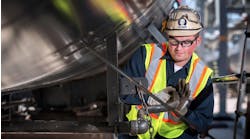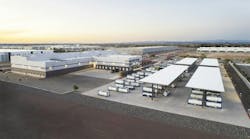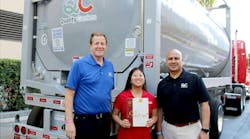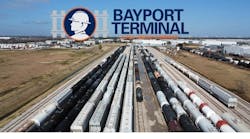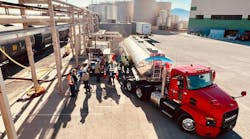Bulk distributors typically deal with a large volume of assets, such as inventory, storage facilities, vehicles, and equipment. They often maintain significantly large amounts of inventory that must be monitored and tracked accurately to prevent overstock or stockouts. Bulk distributors operating in highly regulated industries, such as chemicals, must also ensure compliance with safety, quality, and environmental regulations by tracking and documenting asset conditions and maintenance.
With effective asset management, distributors can control costs by optimizing asset utilization, reducing maintenance expenses, and minimizing asset downtime. Properly managing assets helps mitigate theft, damage, and loss risks. In transloading operations, which involves transferring goods between different modes of transportation, such as rail to truck or ocean container to truck, asset management is particularly important to keep operations streamlined and running smoothly.
Effective asset management also ensures operational efficiency and contributes to cost reduction, safety enhancement, and overall customer satisfaction. By prioritizing the maintenance and optimization of their assets, businesses can maintain a competitive edge in the logistics and transportation industry.
Critical components of asset management
- Infrastructure management involves maintaining and optimizing the physical infrastructure, such as rail sidings, transfer points, loading and unloading facilities, storage areas, and road access, to ensure these assets are in good working condition and can meet safety and regulatory standards. Regular maintenance is crucial to preventing the breakdown of assets and ensuring the longevity of equipment. Maintenance activities should be scheduled and tracked, helping to reduce unexpected downtime.
- Transloading equipment involved in transloading operations includes cranes, conveyor systems, forklifts, and other machinery needed for loading and unloading railcars and transferring goods. Proper maintenance and replacement scheduling are crucial to minimizing downtime.
- Inventory management involves monitoring and controlling the inventory of goods being transloaded. This involves tracking the volume, type, and condition of goods in storage and transit to ensure accurate and timely transfers.
- Safety management ensures that all assets and processes within transloading rail operations comply with safety regulations and industry standards. Safety and compliance management involves safety training, conducting inspections, and promptly addressing safety concerns.
- Resource allocation: Effective asset management requires optimizing resource allocation, including labor and equipment scheduling, to ensure smooth and cost-effective transloading operations.
- Technology integration: Asset managers often rely on technology, such as transportation management systems (TMS) and warehouse management systems (WMS), to track and manage assets, inventory, and operations efficiently. Integrating technology can provide real-time visibility into operations and streamline decision-making.
- Environmental considerations: Sustainable asset management practices in transloading rail operations may involve implementing environmentally friendly technologies and processes to reduce emissions, minimize waste, and conserve resources.
- Performance metrics: Asset managers use key performance indicators (KPIs) to measure the efficiency and effectiveness of transloading operations. These metrics include throughput rates, inventory turnover, asset utilization, and on-time performance.
- Transloading facilities need to be strategically located at the intersection of various transportation networks and are designed to facilitate the transfer of cargo between different types of vehicles or containers. These facilities should be designed to minimize handling and transit times, reduce transportation costs, and optimize the overall supply chain by allowing goods to be transferred quickly and efficiently between transportation modes.
Transloading, asset management, and a TMS
Truckers and rail companies play essential roles in transloading operations, and their interaction is crucial for a smooth and efficient transloading process. Truck fleets usually handle the first and last legs of the transportation process. They pick up cargo from the shipper’s location, transport it to the transloading facility, and then deliver it to the consignee. On the other end, they may pick up cargo from the railhead and deliver it to the recipient. It is essential to track the equipment as it goes through its journey using IoT sensors, GPS devices, AEI tags, or telematics equipment to ensure it arrives on time.
Truck arrivals and departures must match train schedules, ensuring cargo is ready for transfer when railcars or ocean containers arrive at the yard. These schedules must be synchronized within a transportation management system that tracks all assets seamlessly along their journey. The TMS uses AI to predict arrival times and alert operators of any predicted or actual issues. Once the assets arrive on site, it records arrival and departure times and monitors how long they stay at a facility or yard. If an asset stays too long at a specific location, it could disrupt the timely coordination of schedules, resulting in demurrage charges or other detention fees.
At the transloading facility, cargo is transferred between trucks and railcars. Truckers interact with rail company personnel or facility operators to ensure this transfer process is smooth, efficient, and safe. Proper loading and unloading procedures are critical to prevent damage to the cargo. Documentation, which includes bills of lading, shipping instructions, and customs paperwork, can be handled by the TMS so that truckers and rail companies don't have to handle any paperwork that can get lost or destroyed.
Technology such as a TMS for asset management improves transloading operations by helping operators plan labor more efficiently, automating processes, monitoring and tracking assets, and coordinating schedules. The efficient movement of goods between different modes of transportation is vital to meeting customer expectations.
Michael Young is the director of sales and marketing at IntelliTrans.
